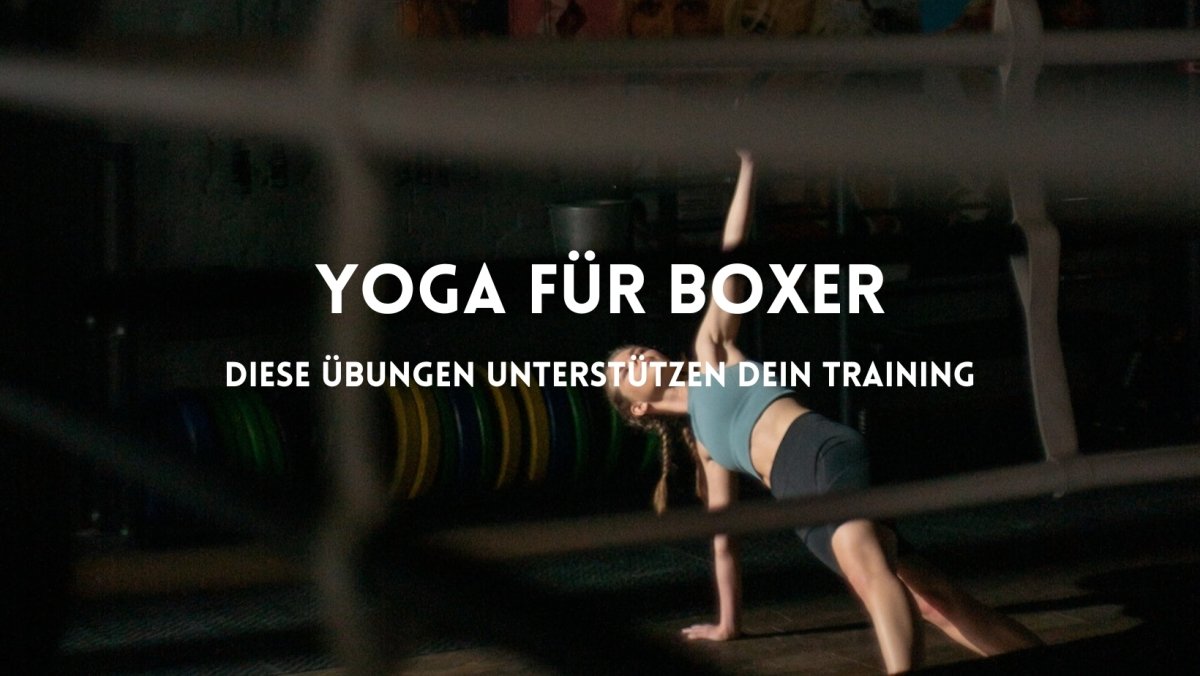
20
Juli
Yoga für Boxer: Wie Yoga-Übungen dein Boxtraining unterstützt!
 Boxing requires strength, speed, power, flexibility and agility – physically and mentally. Yoga is a sport that can effectively support you in your boxing training – on many levels.
Boxing requires strength, speed, power, flexibility and agility – physically and mentally. Yoga is a sport that can effectively support you in your boxing training – on many levels.
What you will learn in this article:
- What yoga is
What advantages yoga has for boxers- How to integrate yoga into boxing training
- Which yoga exercises are suitable for boxers
What is yoga anyway? Briefly explained!
Yoga is the generic term for a teaching originating from India that includes both mental and physical exercises. For some people, the physical benefits of yoga are more important, while others practice it for its meditative aspects. Some people therefore develop yoga into a complete way of life. Others simply use it to stay fit and reduce stress.
What many people do not know: Yoga is not part of any religion, although various practices also appear in religions such as Buddhism.
Yoga is a mixture of:
- Physical exercises
- Meditative exercises< /li>
- Breathing exercises
- Behaviors
- Acquiring certain skills (“asceticism”)
The term “asceticism” comes from Greek and has been used since ancient times to describe self-training in which the practitioner (“ascetic”) learns various skills such as self-control and strength of character. Discipline, strength, self-confidence: These are also important aspects in boxing.
What forms of yoga are there?
As mentioned above, yoga does not only have to involve physical exercises, so there are very different forms. In this country, Hatha yoga is mostly practiced, which combines various physical and mental exercises. But there is also Jnana yoga, for example – a yoga style without any physical exercises. So-called power yoga combines physical exercise with breathing exercises.
How does yoga help a boxer during training?
Hatha yoga, if done correctly, is a physically demanding sport that goes far beyond stretching muscles and ligaments. Many exercises result in a full-body workout that places great physical demands on the practitioner. Since the yoga practiced here is not just a purely physical activity, it can benefit boxers on various levels.
Yoga…
- strengthens the core
- stabilizes the body
- stretches the muscles
- improves flexibility
- contributes to mental relaxation
- reduces stress
- helps to wind down the body
Yoga strengthens the body
In yoga, practitioners work solely with their body weight – especially in conjunction with gravity. Boxers can strengthen their bodies (e.g. the core) in the various yoga positions, ensure greater stability and strengthen muscles. This also affects your sense of balance.
Yoga improves posture
A strong core, strong muscles – this can help to improve your own posture. Even if boxers are slightly bent forward in the basic position, a stable posture is particularly important in order to be able to react quickly and safely to the opponent’s movements and avoid stumbling.
Yoga makes boxers more flexible
Flexibility is extremely important for boxers, not only to be able to dodge blows, but also to land targeted hits themselves. You have to be able to act at lightning speed without being restricted in your mobility. With yoga you not only stretch your muscles, but also prevent tension and injuries to the muscle strands. Stretched, flexible muscles recover faster.
Yoga can improve endurance
Many people associate yoga with slow movements – some even doubt that it is a real sport. But yoga is very demanding and if you do the exercises at a faster pace, you will quickly increase your heart rate. Yoga is therefore a good way to improve your basic endurance when exercising.
Yoga helps reduce stress
Yoga also contains many meditative aspects that bring calm to your body and mind. For example, yoga can help you reduce stress and relax before an important competition. It can also help you to wind down your body after boxing training (keyword: cool down).
Yoga helps boxers with breathing
The topic of “breathing correctly” is very important for boxers. In order to remain efficient over a longer period of time, your body needs oxygen. To do this, it is good if you breathe deeply into your stomach in order to absorb a high amount of oxygen. Yoga includes various breathing exercises that help you as a boxer to breathe deeply and relaxed. This offers benefits both during boxing and after training to wind down the body.
How can yoga be integrated into boxing training?
You have different options for practicing yoga as a boxer. On the one hand, you can make it part of your training routine – for example, after strength training or punching bag training as a cool down. Or you can use it to switch off better after boxing, to stretch your body and to promote regeneration. Of course, you can also practice yoga outside of your boxing training, for example in the morning after getting up. Or you can use it specifically before a competition to calm down and focus.
Which yoga exercises are suitable for boxers?
Downward dog, mountain pose, cat, cobra, warrior, tree: There are so many yoga exercises – asanas – that you can always choose the ones that suit your training goal (e.g. muscle strengthening, stretching, relaxation, breathing exercises, concentration exercises).
We’ll show you some of the most common yoga asanas:
Yoga exercises for muscle strengthening
In theory, many yoga exercises require tensing different muscle groups, but these are particularly helpful in strengthening the muscles:
Plank – Chaturanga
- The starting position for the plank pose is the downward dog or the quadruped stance. You support your outstretched arms and toes on the floor, while the rest of your body floats in the air like a straight board.
- The plank primarily strengthens the core muscles – similar to the well-known plank.
- First lie on your back on the floor and then lift your legs vertically into the air. Your hands support your spine. Make sure that the weight is borne by the shoulders and not by the cervical spine.
- The shoulder stand strengthens the back, abdominal and glute muscles.
Yoga exercises for balance
The fact that you have to keep your body in balance ensures more stability and strengthens the muscles.
Tree -Vrksasana
- Stand firmly and straight on the floor with both feet. Lift one leg and place the sole of your foot on the inside of the standing leg. Your palms meet in a circle above your head.
- The tree pose causes many practitioners to stagger because it challenges your sense of balance. At the same time, it strengthens the core, buttocks and leg muscles.
Warrior – Virabhadrasana
- For the warrior pose, stand on the mat with your legs apart. You shift your weight to one side and bend your knee.
- Your arms are stretched out. Your hips and torso remain centered and are not rotated.
- The warrior is a good yoga exercise for more balance. It also opens the pelvis and chest. It gives strength and self-confidence.
- Your feet are slightly apart on the floor, lift one foot backwards and grab it with your arm. The other arm is stretched out in front of the upper body.
- What looks easy and graceful is hard work. Because the dancer requires your sense of balance along with your body stability. The dancer trains your balance and stretches your hips.
- For the crow pose, sit on your heels (bottom resting on heels). Open your knees so that your arms and upper body can fit through.
- The knees are on the back of your upper arms. Lift your bottom into the air and then push yourself off the ground with your feet. Your knees are still on your upper arms.
- The crow pose only requires strength at first glance, but balance is more important.
Yoga exercises for muscle stretching
Exercises that stretch your muscles, are ideal both before boxing training and during the cool down to prevent injuries and inflammation.
Downward Dog – Adho Mukha Svanasana
- Your feet are flat on the floor, as are your hands. Push your bottom up so that your body forms a triangle that is open towards the mat.
- The downward dog stretches the back of the thighs and the back in particular.
- The starting position is an upright stand with your legs spread. You can also stretch your arms out to the sides. Now bend towards your right foot with your right hand.The left hand goes up, just like your gaze. Then you bend to the other side.
- The stretched triangle stretches the chest, the flanks, the hips and the legs.
- Lie on your stomach on the mat with your arms bent next to your upper body. Press yourself upwards with the palms of your hands so that your back bends.
- The cobra stretches your front side, but also strengthens the muscles in the lumbar region.
- For the twisting seat, sit cross-legged with one leg up (cross the other leg). Fold your hands in front of your middle and slowly rotate – first to the right and then to the left. Only rotate as far as you can, but try to get your elbow behind your raised knee.
- The twisting seat is used to stretch and mobilize the lower back.
Yoga exercises for relaxation
Relaxation exercises are always great for cooling down, i.e. the time after an intensive boxing workout. This is how you can help your body to recover and regenerate.
Child’s Pose – Garbhasana
- Sit in the heel seat, bend your upper body forward and let your arms fall back to the sides.
- The child’s pose stretches the back in particular and relaxes the abdominal muscles.
- For the lotus position, sit on the mat with your back straight, your knees bent and your Feet cross over each other. Place your arms on your knees and form a circle with your index finger and thumb.
- The lotus position is ideal for meditation and breathing exercises, and is therefore ideal for relaxation after training.
- The corpse pose is the yoga exercise that apparently does not require any physical tension or strength, but is still not easy. Simply lie on your back on the mat. Your legs are stretched out, your arms are at your sides. Try to relax all your muscles and joints during this exercise. Your breathing remains shallow and calm.
- The corpse pose ensures absolute deep relaxation after training.
Photo by cottonbro studio on Pexels











